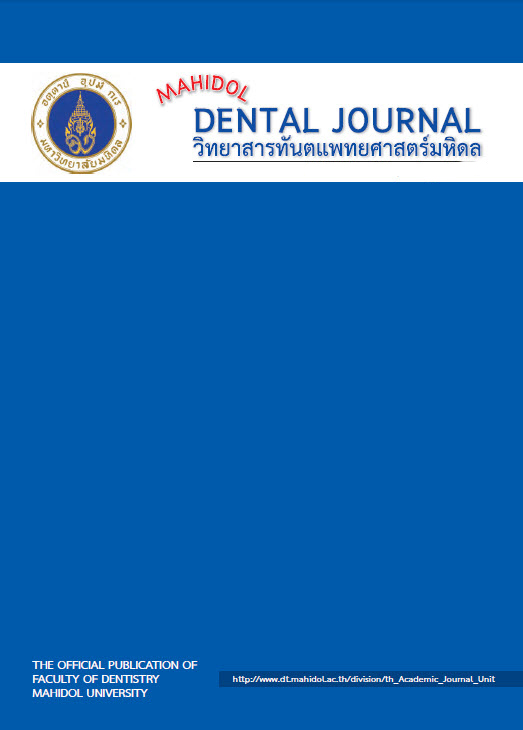The effect of ocimum sanctum oil on human squamous cell carcinoma (HSC-4) in Vitro
Main Article Content
Abstract
Objectives: This study aimed to investigate the effect of oil from Ocimum sanctum on cytotoxicity and cell migration of human squamous cell carcinoma.
Materials and methods: The concentrations of Ocimum sanctum oil used in this study were 0.02%, 0.002%, 0.0002% and 0.00002% (v/v). Human squamous cell carcinoma (HSC-4) at a concentration of 1x105 cells/ml was seeded and cultured in 96-well plate. The percentage of cell viability was analyzed by MTT assay and the migration areas were measured using Image-Pro Plus version 7.
Results: It was found that the percentages of human squamous cell carcinoma viability after exposure to 0.02, 0.002, 0.0002 and 0.00002% (v/v) of O. sanctum were 94.44±4.216, 95.13±3.061, 105.55±3.14 and 107.63±3.54, respectively (Table1). Regarding cell migration, all concentrations of O. sanctum could inhibit HSC-4 migration.
Conclusion: O. sanctum oil at concentration of 0.02, 0.002, 0.0002 and 0.00002% (v/v) had no cytotoxic activity on HSC-4 whereas inhibitory effect on cell migration was observed. Our data could be basic knowledge for the benefit of using this oil in oral cancer prevention or treatment. Further studies are still needed to clarify mechanisms of actions of this oil.
Keywords: Cytotoxicity, Migration, Ocimum sanctum, Squamous cell carcinoma
Article Details
References
2. World Health Organization. Oral health: oral cancer; 2019
3. Suparp K, Hutcha S, and William W. Genetic and environmental interactions on oral cancer in Southern Thailand. Environ Mol Mutagen 2001; 37: 111-116.
4. Sandip GB, Sheetal SB, Niraj DM. A review article on Ocimum Sanctum Linn. JAHM 2014; 22: 1-6.
5. Balakumar, S, Rajan S, Thirunalasundari T, Jeeva S. Anifungal activity of Ocimum sanctum Linn. (Lamiaceae) on clinically isolated dermatophytic fungi. Asian Pac J Trop Med 2014; 4: 654-7.
6. Gopalkrishna AH, Seshagiri M, Muddaiah S, Shashidara R. In vitro antifungal activity of different components of Centratherum anthelminticum and Ocimum sanctum seed oils and their synergism against oral pathogenic fungi. J Dent Res Dent Clin Dent Prospects 2016; 10: 92-8.
7. Zaidi KU, Shah F, Parmar R, Thawani V. Anticandidal synergistic activity of Ocimum sanctum and fluconazole of azole resistance strains of clinical isolates. J Mycol Med 2018; 28: 289-3.
8. Kaypetch R, Muadcheingka T, Tonput P. Antibacterial activity of Ocimum sanctum oil against Streptococcus mutans: in vitro. M Dent J 2015; 35: 311-9.
9. Agarwal P, Nagesh L. Evaluation of the antimicrobial activity of various concentrations of Tulsi (Ocimum sanctum) extract against Streptococcus mutans: An in vitro study. Indian J Dent Res 2010; 21: 357-9.
10. Ghoke SS, Sood R, Kumar N, Pateriya AK, Bhatia S, Mishra A, et al. Evaluation of antiviral activity of Ocimum sanctum and Acacia arabica leaves extracts against H9N2 virus using embryonated chicken egg model. BMC Complement Altern Med 2018; 18: 174.
11. Bhattacharyya P, Bishayee A. Ocimum sanctum Linn. (Tulsi): An ethnomedicinal plant for the prevention and treatment of cancer. Anti-Cancer Drugs 2013; 24: 659-66.
12. Nakamura CV, Ishida K, Faccin LC, Filho BPD, Cortez DAG, Rozental S, de Souza W and Ueda-Nakamura T. In vitro activity of essential oil from Ocimum gratissimum L. against four candida species. Curr Res Microbiol Biotechnol 2004; 155(7): 579-86.
13. Shivpuje P, Ammanangi R, Bhat K, Katti S. Effect of Ocimum sanctum on oral cancer cell line: An in vitro study. J Contemp Dent Pract 2015; 16: 709-14.


